Before we can get too deep into our discussion of multi-engine aerodynamics, we need to define some terms.
Vmc: The airspeed at which directional control of the airplane is no longer possible due to insufficient rudder authority to oppose yaw from one engine being inoperative. While this is commonly referred to as an airspeed or V-speed, it is also a condition that the airplane is in. Put a different way, if you have an engine force Fe that is attempting to yaw the airplane and a rudder force Fr to oppose yaw, Fr ≥ Fe to maintain directional control of the aircraft.
Critical engine: The engine, when lost, most adversely affects the controllability of the airplane. In conventional twins, where props rotate clockwise (think Baron or C414), the left engine is critical. In counter-rotating twins (think Seminole or Seneca), neither engine is critical. In contra-rotating twins, both engines are critical.
Note that I am referring to controllability over performance. The performance will already be reduced (and we’ll see how much below), but the name of the game when operating on one engine is directional control.
Multi-Engine Aerodynamic Factors
There are four factors (acronym: PAST) contributing to how a multi-engine airplane reacts when operating on one engine. Note that none of these factors act in isolation to each other—they all compound each other to affect the controllability of the aircraft.
P-Factor: At low airspeed and high angles of attack, the descending blade of the propeller produces more thrust than the ascending blade. The descending blade on the right engine has a longer arm from the CG than the descending blade of the left engine. This greater arm can exert more force, thus creating a yawing force to the left.
In a counter-rotating twin, the length of the arm from the greatest thrust is the same whether the left or the right engine are inoperative. This means that neither the left nor the right engine will have any more adverse effect than the other. The effect of either engine being inoperative will be the same.

Accelerated Slipstream: As a result of P-Factor, stronger induced lift is produced on the descending blade by its prop wash. The image shows the amount of induced lift with the light blue arrows. The greatest induced drag on the right wing, is further from the CG that the greatest induced drag on the left wing. This creates a rolling effect to the left.
In a counter-rotating twin, the length of the arm from the greatest induced lift is the same whether the left or the right engine are inoperative. Meaning, neither the left nor the right engine will have any more adverse effect than the other. The effect of either engine being inoperative will be the same.

Spirialing Slipstream: As a result of P-Factor, the extra thrust being created by the descending blade is causing a lower pressure than on the left side. High pressure always moves to low pressure, which causes the rotation of the air. In the case of the conventional twin, the spiraling slipstream hits the left side of the empennage and vertical stabilizer. This pushes it right, invoking Newton’s 3rd Law of Motion (equal and opposite reaction) and cause the nose to yaw to the left.
In a counter-rotating twin, because the right engine is rotating counter clockwise, the low pressure is now on the left side of the engine. This creates a senecio where no matter what engine is inoperative, they will both have a spiraling slipstream towards the vertical stabilizer.
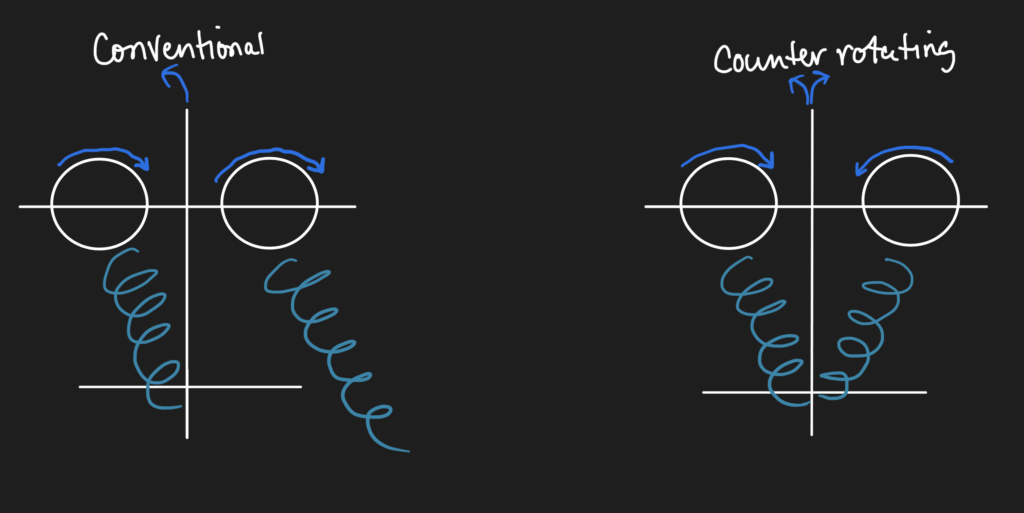
Torque: For every action there is an opposite an equal reaction (Newton 3rd Law of Motion). As a result of the propellers turning clockwise on a conventional twin, there is a left rolling tendency of the airplane.
In a counter-rotating twin, no matter which engine is inoperative, torque will oppose the roll created by asymmetric thrust.
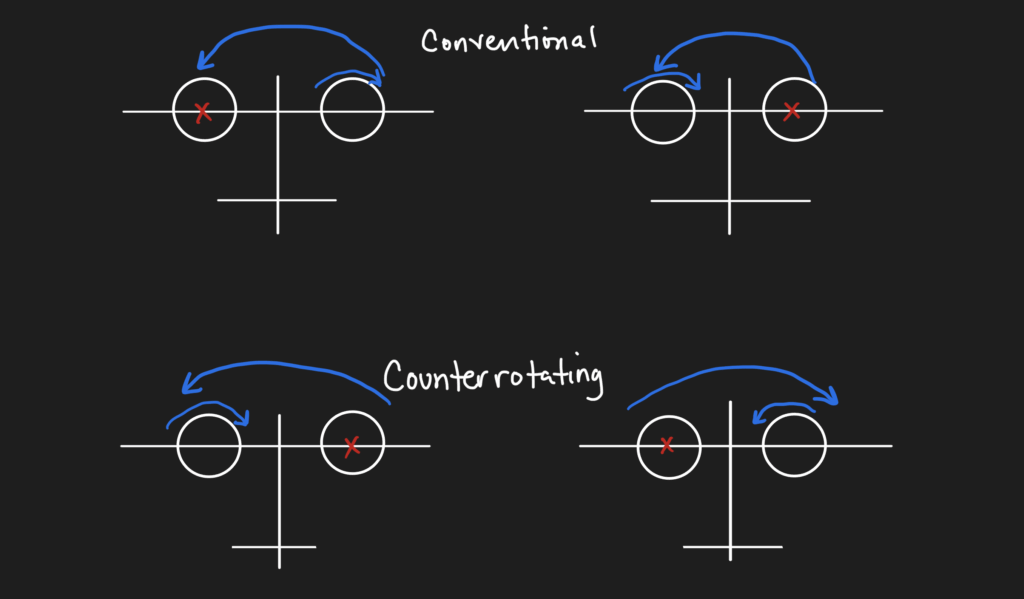
Factors Affecting Vmc
As mentioned, Vmc is an airspeed. For example, in the Baron 55, it is 78 knots. However, Vmc can change based upon conditions (acronym: SMACFUMO).
FAR 23.149 standardizes determining Vmc which could otherwise allow for a higher published Vmc speed than the speed at which the aircraft will actually lose directional control with one engine inoperative. Under these conditions, the test pilot must be able to stop the turn that results in the critical engine being made inoperative within 20 degrees of the original heading, using maximum rudder deflection (not to exceed 150 pounds), and max 5 degrees bank into the operating engine and, thereafter maintain straight flight with not more than 5 degrees of bank.
Note: The value of Vmc published in the POH is the maximum it will ever be, as an average of the items listed below. It can be significantly higher if, for example, you remove bank or deviate from zero-sideslip.
Standard Day: 29.92Hg and 15C. For normally-aspirated engines, density altitude & Vmc are inversely related. A high density altitude will result in a lower Vmc speed. This is due to the engine and propeller being less efficient at a higher density altitude and making less power than compared to sea level. This in turns lessens PAST factors and reduces the need for counteracting rudder.
Max Power: Setting max power on the operating engine creates the greatest asymmetric thrust (high power setting creates most unfavorable PAST conditions), so reducing power would increase controllability.
Aft Loading: An aft CG is far more undesirable than a forward one because with an aft CG shortens the arm to the center of the rudder’s horizontal lift, which means a higher airspeed would be required to counteract the engine-out yaw. With a forward CG, the arm is longer and the rudder is able to exert more force at a lower airspeed.
Critical Engine Propeller Windmilling: This is the single most influential factor to Vmc. A windmilling propeller creates a significant amount of unbalanced drag. Feathering the propeller into the relative wind reduces Vmc and drag and increases controllability.
Flaps Up/Gear Up: Having flaps and gear down increases directional stability, similar to the keel of a boat (in fact, it is called the Keel Effect). This is because there is a change in CG when the landing gear is put down and may make the rudder more effective due to a longer arm (lowering Vmc). The extended gear may have an effect to weathervane the airplane into the relative wind, which can be directionally stabilizing. Extended flaps would generate more lift, and more drag, which may oppose the yawing motion of the dead engine.
Up To 5 Degrees of Bank: If I had to choose another single most important factor of Vmc, this would be it. During engine-out flight, keeping the ball centered and the wings level will actually cause a side-slip situation because of the one failed engine and the resulting drag and loss of lift. A sideslip would make stall characteristics worse, would decrease climb and acceleration capability, and would increase Vmc. Turning up to 5 degrees towards the good (operating) engine will prevent the airplane from being in a sideslip condition, will improve climb capabilities, improve stall capabilities, improve performance and will decrease Vmc. Vmc increases 3 knots per degree angle of bank towards the dead engine. This is limited to 5 degrees because bank helps maintain directional control through the horizontal component of lift and the certification standards didn’t want an unreasonable amount of bank to get artificially low Vmc numbers.
Most Unfavorable Weight: The most unfavorable weight is light weight. Vmc is not affected by weight in straight and level flight, only by the weight of the airplane in a bank. When it is banked, a component of the aircraft weight acts along with the horizontal component of lift to create a more effective sideslip towards the operating engine.
Out Of Ground Effect: An aircraft in ground effect is “cushioned”, with less drag and greater lift. So in ground effect, Vmc decreases. As the aircraft lifts out of ground effect, it loses that lift and increases its drag, thereby increasing the Vmc.
Below is a table of factors and how they affect performance, controllability and Vmc. Note that often times, controllability and performance are inversely correlated.
| Factor | Performance | Controllability | Vmc |
| Standard Conditions (29.92Hg, 15C) | ↑ | ↓ | ↑ |
| Max Power (on operating engine) | ↑ | ↓ | ↑ |
| Aft CG (greatest allowable) | ↑ | ↓ | ↑ |
| Critical Engine Propeller Windmilling | ↓ | ↓ | ↑ |
| Flaps and Landing Gear (Up) | ↑ | ↑ | ↑ |
| Up to 5º Bank into the Operating Engine | ↑ | ↑ | ↓ |
| Most Unfavorable Weight (Lightest) | ↑ | ↓ | ↑ |
| Airborne (out of ground effect) | ↓ | ↑ | ↑ |
| Trimmed (for takeoff) | — | ↑ | ↓ |
| Cowl flaps (open) | — | ↑ | ↑ |
The FAA lists “Trimmed for Takeoff” and “Cowl Flaps” as factors, but in my opinion, the effect is negligible.
Static Versus Dynamic VMC Certification
- The dynamic demonstration is used to publish an aircraft’s Vmc speed. It is determined under the conditions outlined in FAR 23.149.
- Dynamic: In dynamic Vmc certification, test pilots cut the critical engine at gradually reduced speeds to find the minimum speed where directional control can be maintained within 20° of the original heading. This involves high power settings and quick pitch adjustments, making it too risky for typical flight training.
- Static: Static Vmc certification involves maintaining straight flight with up to 5° of bank toward the operating engine. This method is safer and more closely reflects Vmc demonstrations in flight training.
Vmc vs Vs
Some consideration needs to be given to the variable nature of Vmc and how it interacts with Vs. While Vmc decreases with altitude, Vs remains the same. There exists an altitude where each of the following exists:
- Vmc is less than Vs (stall occurs first)
- Vmc is the same as Vs (stall and yaw coincide)
- Vmc is greater than Vs (yaw occurs first)
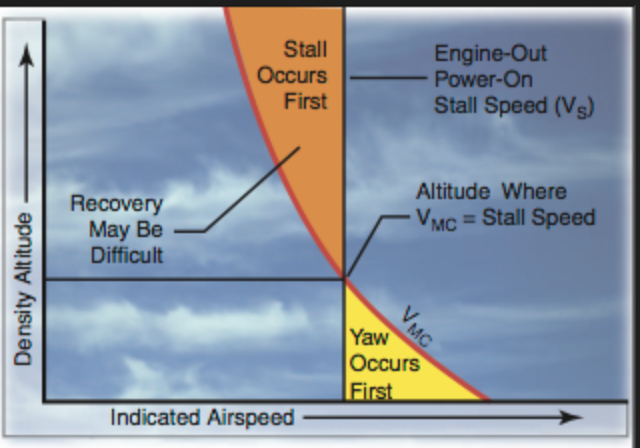
The density altitude where Vmc and Vs are equal is called the critical density altitude (don’t confuse this with the “critical altitude” of turbocharged engines—they’re different). Here, the airplane will “stall and yaw” simultaneously under a condition of asymmetrical thrust. The airplane could experience an abrupt change in attitude or enter into a spin. The altitude you choose to demo Vmc at should take this into consideration because choosing a higher altitude doesn’t necessarily make the maneuver safer.
Being at an altitude where Vmc is less than or equal to Vs is dangerous. This means you will stall before you lose directional control and you’ve just supplied all of the necessary prerequisites for entering a spin (airfoil stalled and an imbalance of lift).
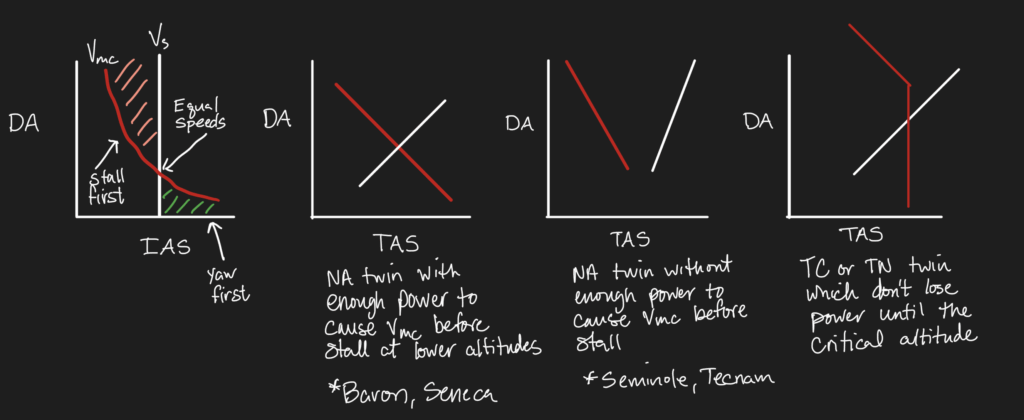
One Engine Inoperative Performance
Did you know that only certificated airplanes with a takeoff weight of greater than 6,000 pounds are required to be able to climb on a single engine? That light twin you’re flying—it may or may not provide adequate performance to climb on one engine.
When an engine is inoperative in a multi-engine aircraft, how much performance is lost? Naturally, most people would think 50% because one engine is 50%. However, the performance that is lost is closer to 80%-90%.
It is true that 50% of the power is lost. Consider this example:
Suppose an airplane has two 260 HP engines. This results in a total of 520 HP (2 x 260 = 520). Let’s further suppose that to sustain straight and level flight in this airplane, it requires 200 HP. When an engine is lost, there is 260 HP total remaining (520 – 260 = 260). This isn’t the end of the story however. Recall that the airplane requires 200 HP for straight and level flight. This leaves the pilot with a meager 60 HP to climb (260 – 200) and since the ability to climb depends on excess thrust/power, any deviation from zero-sideslip condition could negate that advantage. It may work out that this 60HP only gives the pilot 100-200 FPM and potentially, at higher altitudes, this would result in the inability to climb or even force a descent. This is called “drift down.” The altitude at which only 50 FPM (on one engine) is called the OEI service ceiling (which varies on conditions). The altitude at which 0 FPM (on one engine) is called the OEI absolute ceiling (which varies on conditions).
Why is this something you should calculate? At a high density altitude airport, it is possible that the OEI absolute ceiling is below the current density altitude. That means the airplane won’t be able to climb and will actually descend. This is especially a problem at airports with terrain surrounding it. Never, ever takeoff from an airport that exceeds the OEI absolute service ceiling. Lastly, ensure that you always have an accelerate-stop distance, which I’ll talk about in a future post.
Summary
Multi-engine aerodynamics involve understanding Vmc, the critical engine, and four aerodynamic factors (PAST) affecting controllability. Vmc varies based on conditions (SMACFUMO), with factors like density altitude, power setting, and propeller configuration influencing it. Understanding these factors is crucial for safe operation on one engine.


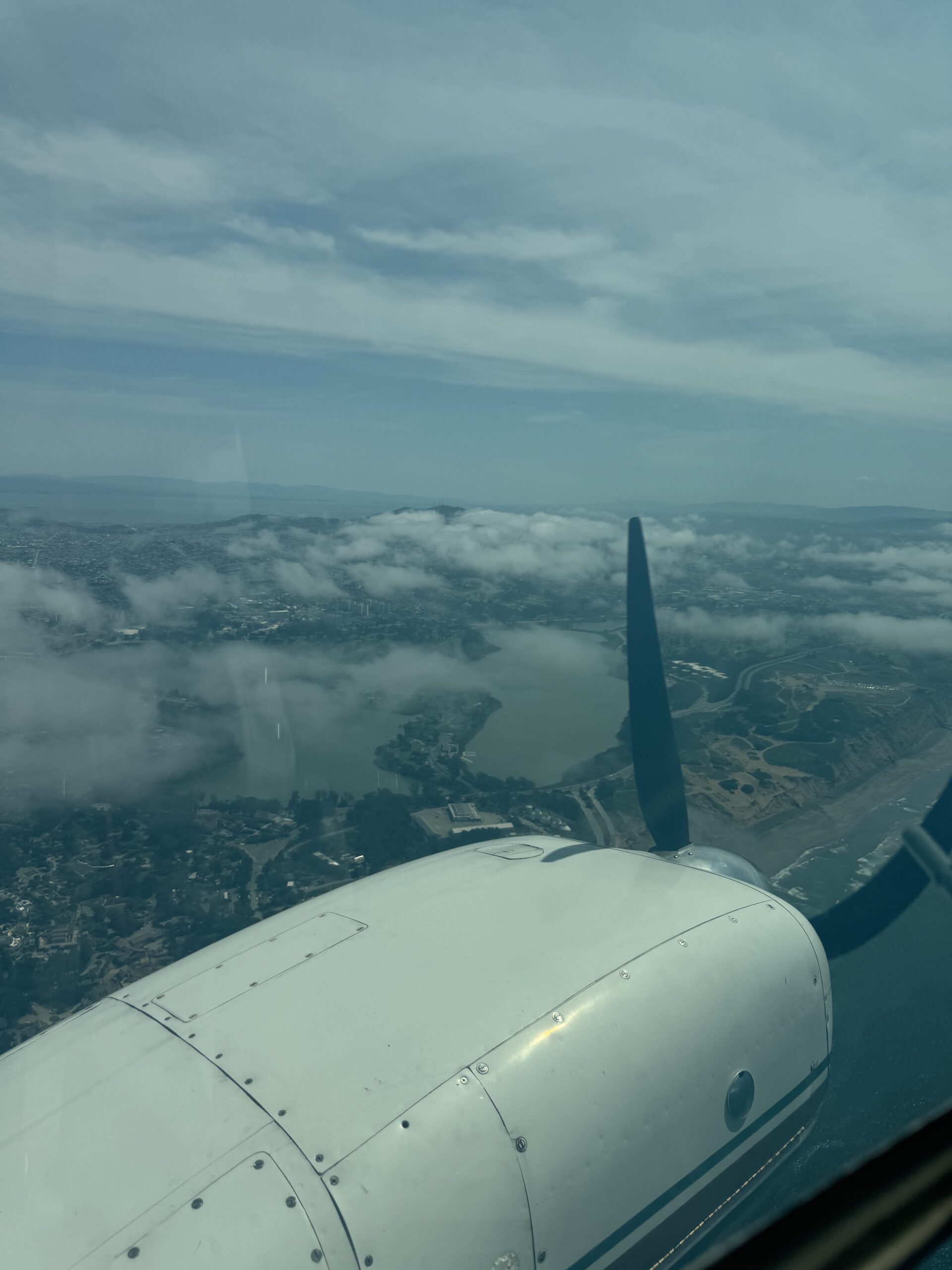
Comments are closed